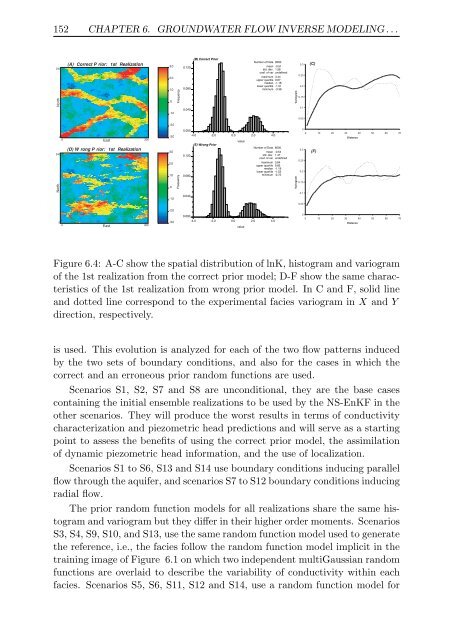Upscaling and Inverse Modeling of Groundwater Flow and Mass ...
Upscaling and Inverse Modeling of Groundwater Flow and Mass ...
Upscaling and Inverse Modeling of Groundwater Flow and Mass ...
Create successful ePaper yourself
Turn your PDF publications into a flip-book with our unique Google optimized e-Paper software.
152 CHAPTER 6. GROUNDWATER FLOW INVERSE MODELING . . .<br />
240<br />
North<br />
(A) Correct P rior: 1st Realization<br />
.0<br />
.0 East<br />
300<br />
240<br />
North<br />
(D) W rong P rior: 1st Realization<br />
.0<br />
.0 East<br />
300<br />
3.0<br />
2.0<br />
1.0<br />
.0<br />
-1.0<br />
-2.0<br />
-3.0<br />
3.0<br />
2.0<br />
1.0<br />
.0<br />
-1.0<br />
-2.0<br />
-3.0<br />
Frequency<br />
Frequency<br />
0.120<br />
0.080<br />
0.040<br />
0.000<br />
0.120<br />
0.080<br />
0.040<br />
0.000<br />
(B) Correct Prior<br />
-4.0 -2.0 0.0 2.0 4.0<br />
(E) Wrong Prior<br />
value<br />
value<br />
Number <strong>of</strong> Data 8000<br />
mean -0.51<br />
std. dev. 1.56<br />
coef. <strong>of</strong> var undefined<br />
maximum 3.44<br />
upper quartile 0.67<br />
median -1.16<br />
lower quartile -1.51<br />
minimum -3.39<br />
Number <strong>of</strong> Data 8000<br />
mean -0.54<br />
std. dev. 1.47<br />
coef. <strong>of</strong> var undefined<br />
maximum 3.64<br />
upper quartile 0.85<br />
median -1.19<br />
lower quartile -1.53<br />
minimum -2.72<br />
-4.0 -2.0 0.0 2.0 4.0<br />
Variogram<br />
0.3<br />
0.25<br />
0.2<br />
0.15<br />
0.1<br />
0.05<br />
(C)<br />
0<br />
0 10 20 30 40 50 60 70<br />
0.3<br />
0.25<br />
0.2<br />
0.15<br />
0.1<br />
0.05<br />
Distance<br />
0<br />
0 10 20 30 40 50 60 70<br />
Figure 6.4: A-C show the spatial distribution <strong>of</strong> lnK, histogram <strong>and</strong> variogram<br />
<strong>of</strong> the 1st realization from the correct prior model; D-F show the same characteristics<br />
<strong>of</strong> the 1st realization from wrong prior model. In C <strong>and</strong> F, solid line<br />
<strong>and</strong> dotted line correspond to the experimental facies variogram in X <strong>and</strong> Y<br />
direction, respectively.<br />
is used. This evolution is analyzed for each <strong>of</strong> the two flow patterns induced<br />
by the two sets <strong>of</strong> boundary conditions, <strong>and</strong> also for the cases in which the<br />
correct <strong>and</strong> an erroneous prior r<strong>and</strong>om functions are used.<br />
Scenarios S1, S2, S7 <strong>and</strong> S8 are unconditional, they are the base cases<br />
containing the initial ensemble realizations to be used by the NS-EnKF in the<br />
other scenarios. They will produce the worst results in terms <strong>of</strong> conductivity<br />
characterization <strong>and</strong> piezometric head predictions <strong>and</strong> will serve as a starting<br />
point to assess the benefits <strong>of</strong> using the correct prior model, the assimilation<br />
<strong>of</strong> dynamic piezometric head information, <strong>and</strong> the use <strong>of</strong> localization.<br />
Scenarios S1 to S6, S13 <strong>and</strong> S14 use boundary conditions inducing parallel<br />
flow through the aquifer, <strong>and</strong> scenarios S7 to S12 boundary conditions inducing<br />
radial flow.<br />
The prior r<strong>and</strong>om function models for all realizations share the same histogram<br />
<strong>and</strong> variogram but they differ in their higher order moments. Scenarios<br />
S3, S4, S9, S10, <strong>and</strong> S13, use the same r<strong>and</strong>om function model used to generate<br />
the reference, i.e., the facies follow the r<strong>and</strong>om function model implicit in the<br />
training image <strong>of</strong> Figure 6.1 on which two independent multiGaussian r<strong>and</strong>om<br />
functions are overlaid to describe the variability <strong>of</strong> conductivity within each<br />
facies. Scenarios S5, S6, S11, S12 <strong>and</strong> S14, use a r<strong>and</strong>om function model for<br />
Variogram<br />
(F)<br />
Distance


